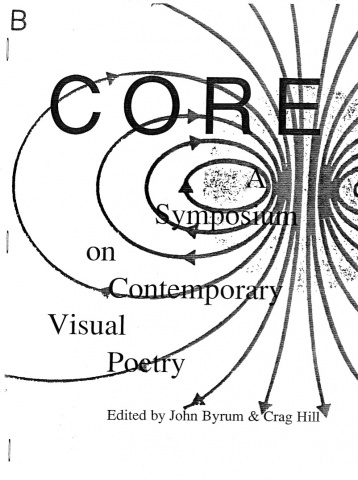John Byrum, Crag Hill (eds.): Core: A Symposium on Contemporary Visual Poetry (1993)
Filed under book | Tags: · concrete poetry, language, literary theory, literature, mail art, poetry, visual poetry

“CORE consists of materials sent in response to a questionnaire on visual poetry developed and distributed by Crag Hill and John Byrum. The questionnaire was distributed to approximately 200 people in several countries whose efforts have been largely concerned with visual poetry. Nearly all of the respondents consider at least some of their literary work as visual poetry or visual literature.
The responses constitute a core sample of the issues, methods, and practices of contemporary visual poetry, and of the respondents’ perceptions regarding its situation within contemporary culture. Respondents were encouraged to deal with the ‘spirit’ of the issues raised by the questionnaire as much as with the particular questions themselves.” (from the Introduction)
Contributions by Johanna Drucker, Charles Bernstein, Dick Higgins, Richard Kostelanetz, Steve McCaffery, Eduardo Kac, among many others.
Publisher Generator Press, Mentor/OH, and Score, Mill Valley/CA, 1993
ISBN 0945112165
156 pages
via imagenigma
Peter Bürger: Theory of the Avant-Garde (1974–) [DE, EN, ES, PT, CZ]
Filed under book | Tags: · 1920s, aesthetics, art, art criticism, art history, art system, art theory, avant-garde, collage, literary theory, literature, modernism

“In this volume, Peter Bürger formulates a theory of the ‘institution of art’. He argues that the social status of literature and art cannot be explained by making simple, direct links between the contents of individual works and social history. Rather, he holds, it is the social status of art, its function and prestige in society, that provides the connection between the individual art work and history. Bürger’s concept of the institution of art establishes a framework within which a work of art is both produced and received.
The French and German literary and visual avant-garde of the 1920s provides the test of Bürger’s theory. Focusing on the role of the artistic manifesto and, particularly, on the collage as an art form, he shows how avant-garde movements questioned the autonomous, self-referential status of art in bourgeois society and thus represented a radical break with the aestheticism of high modernism. Bürger attacks metaphysical aesthetics and argues instead for a materialistic aesthetic theory for today, one that is rooted in the reality of the social sphere. His theory calls into question any conventional concept of art derived from Romantic notions of organic unity.
Theory of the Avant-Garde provoked such discussion in Germany that its publisher, Suhrkamp Verlag, issued a book of responses that was more than twice the size of Bürger’s own book.” (from the back cover)
German edition
Publisher Suhrkamp, Frankfurt am Main, 1974
Second edition, 1993
147 pages
English edition
Translated by Michael Shaw
Foreword by Jochen Schulte-Sasse
Publisher University of Minnesota Press, 1984
Theory of History and Literature series, 4
ISBN 0816610673
134 pages
Reviews: Benjamin Buchloh (Art in America, 1984), Leah Ulansey (MLN, 1984), Daglind Sonolet (Telos, 1984), Michael T. Jones (German Quarterly, 1986), Martin Vrba (A2, 2016, CZ).
Publisher (DE)
Publisher (EN)
Publisher (CZ)
Theorie der Avantgarde (German, 2nd ed., 1974/1993, updated on 2020-10-13)
Theory of the Avant-Garde (English, 1984, assembled from various sources, no OCR, updated to full version on 2014-5-12 via Charles, updated to OCR version on 2016-1-23 via a2, 12 MB)
Teoría de la vanguardia (Spanish, trans. Jorge García, 1987), 3rd edition (2000, 51 MB)
Teoria da vanguarda (Portuguese, trans. Ernesto Sampaio, 1993)
Teorie avantgardy (Czech, trans. Václav Magid, 2015, added on 2020-4-5)
See also Bürger’s essay Avant-Garde and Neo-Avant-Garde: An Attempt to Answer Certain Critics of Theory of the Avant-Garde, 2010.
Comments (4)Letters of Marshall McLuhan (1987)
Filed under book | Tags: · biography, communication technology, language, literary theory, mass media, media, media theory, print, technology, television

McLuhan corresponded with a vast number of people, including Duke Ellington, Woody Allen, Jacques Maritain, Rollo May, Susan Sontag, Eugene Ionesco, Wyndham Lewis, Ezra Pound, Bob Newhart, Hubert Humphrey and Jimmy Carter.
Heavily annotated, the letters are arranged in three sections, each with a period introduction: 1931-1936 takes McLuhan through the University of Manitoba and Cambridge University. 1936-1946 covers one year’s teaching at the University of Wisconsin; two years at Saint Louis University; one year, with his bride, at Cambridge for work on his Ph.D.; four more years at Saint Louis; and two years as Assumption College, Windsor, Ontario. These letters include a large correspondence with Wyndham Lewis. The last section begins in 1946, when McLuhan went to the University of Toronto. Two years later he began a long correspondence with Ezra Pound. Covering the period of McLuhan’s fame, it ends in September 1979 with a letter to Pierre Elliott Trudeau, written shortly before McLuhan had a stroke that rendered him speechless.
These letters have been selected from a large collection, now in the Public Archives of Canada, and offer a valuable commentary on McLuhan’s work and, in some instances, the most lucid and detailed explanation of his ideas available.
Selected and edited by Matie Molinam, Corrine McLuhan, and William Toye
Publisher Oxford University Press, 1987
ISBN 0195405943
562 pages
Review (R.D. Berg, Canadian Journal of Communication, 1988)
Review (Frank Kermode, London Review of Books, 1988)
PDF (189 MB, no OCR, any help in reducing the size is welcome!)
Comment (1)
